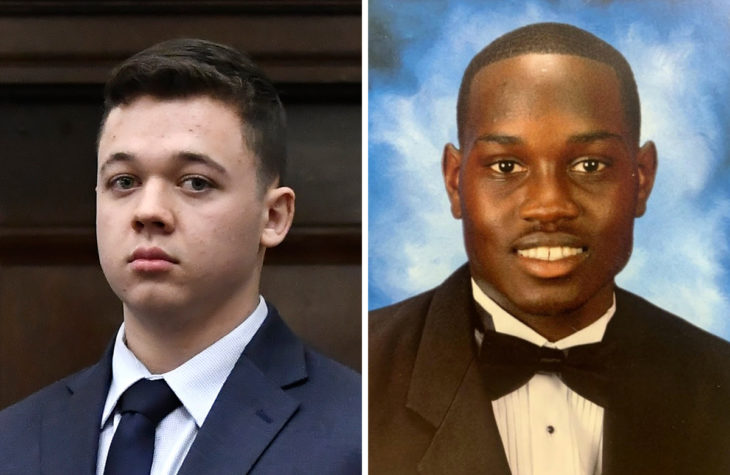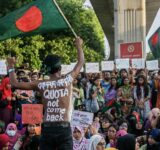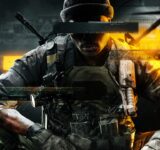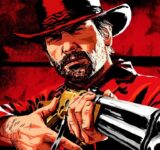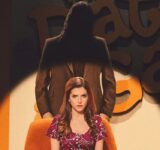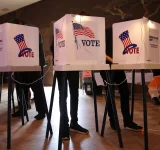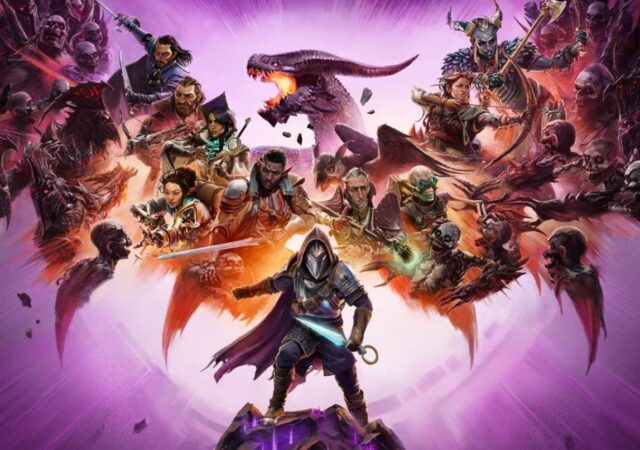After about 27 hours of deliberation, a jury found Kyle Rittenhouse, 19, not guilty of homicide on Nov. 19. As he walked out of the Kenosha, Wisconsin, courthouse, demonstrators waved signs supporting him, while others expressed disappointment. Regardless, the case is monumental in further dividing an already polarized United States.
“I don’t know how they came to the final conclusion that he’s innocent, but this is why African Americans say the whole damn system is guilty,” said Justin Blake, uncle of Jacob Blake.
On Aug. 23, 2020, Jacob Blake was shot and wounded by a white Kenosha police officer, Rusten Sheskey, sparking protests across Wisconsin over police brutality against Black Americans, with some engaging in property damage and arson.
Rittenhouse had kept up with the news in Kenosha. His father lived in Kenosha, and Rittenhouse claimed the owner of the car dealership Car Source, which has three locations in Kenosha, asked Rittenhouse to defend his private property.
On the third day of protests, Rittenhouse arrived in Kenosha with friend Dominick Black, who is charged with two counts of intentionally giving a dangerous weapon to someone under 18, causing death after purchasing an AR-15 style rifle for then underage Rittenhouse.
On Aug. 25, he crossed state lines from his native Illinois into Kenosha, strapped on that AR-15-style semiautomatic rifle, and along with other gun-wielding people, stood by the store as cars on the lot burned.
Later in the night, he left the business and started walking through a crowd of people and pointed his gun at 36-year-old Joseph Rosenbaum. In response, Rosenbaum walked toward Rittenhouse to take the weapon and prevent anyone from being shot.
Instead, Rittenhouse opened fire and shot Rosenbaum four times, as well as Anthony Huber, 26. Both died, while Gaige Grosskreutz, now 27, was wounded.
Rittenhouse faced five charges, including first-degree intentional homicide, first-degree reckless homicide, and first-degree attempted intentional homicide. He pleaded not guilty to them all.
Despite video evidence across social media over the shooting, the outcome of his trial was uncertain from day one. Before the trial started, he addressed the jury.
For instance, Circuit Judge Bruce Schroeder forbade prosecutors from referring to Rosenbaum and Huber as victims because it is a “loaded term.” Still, the defense could call them “looters” and “arsonists” if they proved that.
The judge’s biases were further displayed when his phone rang briefly during the trial, revealing his ringtone was “God Bless the U.S.A.,” a song known to be played at Donald Trump’s rallies.
Additionally, one of the easiest points to prove for the prosecution would have been the possession of a dangerous weapon by a minor, a violation of Wisconsin law. Citing a 1991 case, however, the judge threw out the charge before the trial started because Rittenhouse’s gun was not short-barreled, and that case had declared using a non-short-barreled gun was legal.
“For a jury trial, if you get him, you are happy as a defense attorney,” Michael Cicchini, a criminal defense attorney based in Kenosha, Wisconsin, explained to The Washington Post.
Already skewed by the judge’s leanings toward the defense, the trial boiled down to whether the prosecution could prove that Rittenhouse had not acted in self-defense as he claimed; a Herculean task.
“When people look at this, and they’re feeling frustrated, they’re not recognizing just how high the prosecutors’ burden is here,” Cecelia Klingele, a University of Wisconsin law professor, said. “It was a real uphill battle to get out from under self-defense.”
According to Wisconsin law, if the person has “exhausted every other reasonable means to escape from or otherwise avoid death or great bodily harm,” deadly force is permissible. Simultaneously, Wisconsin has an open carry law.
Rittenhouse argued that he had brought a gun to defend himself against protestors, and then his reason for shooting Rosenbaum was that he was afraid his own gun would be used against him.
To prove that Rittenhouse was not acting in self-defense meant convincing the jury that he came to Kenosha intending to kill.
One argument the prosecution presented was that Rittenhouse was a “fraud,” who had lied about being an emergency medical technician on the night of the shooting. He claimed that he tried to provide medical support, but he had no medical certification.
“I told him I was an EMT but I wasn’t,” Rittenhouse testified.
They also attempted to prove that he was a reckless vigilante.
Sahil and Anmol Khindri, members of the family that owns Car Source, testified that the brothers had met with Rittenhouse, but they alleged they did not ask him to defend their business’ property.
“When the defendant provokes this incident, he loses the right to self-defense,” Kenosha Assistant District Attorney Thomas Binger said.” You cannot claim self-defense against a danger you create.”
In his recount of events, Rittenhouse argued he was a victim.
“As I’m running past Mr. Huber, he’s holding a skateboard like a baseball bat and he swings it down and I block it with my arm trying to prevent it from hitting me, but it still hits me in the neck,” Rittenhouse said. “And as I block it, it goes flying somewhere off into the distance.”
One of the unforgettable moments of the trial was when he broke down on the witness stand, a moment that some have questioned.
Ultimately, the prosecution did not convince the jury, who found him not guilty on all counts.
Rittenhouse appeared to burst into tears after the verdict was read and many Americans rejoiced, while others were outraged.
Rep. Paul Gosar, who was censored this week for tweeting a video of himself killing a character with Rep. Alexandria Ocasio-Cortez in an edited anime video, supported the jury’s decision.
“Justice was served for #KyleRittenhouse and he is fully exonerated. As I said last year, obviously self-defense. I will arm wrestle @mattgaetz to get dibs for Kyle as an intern,” he tweeted.
The Rev. Al Sharpton said the decision is “an obvious signal that encourages and notifies ‘vigilantes’ that they can continue to use violence to assert their power, and more importantly that they are above the criminal justice system when they do.”
The past years have shown no shortage of mass shootings. From the killing Charleston Church shooting in 2015 to the murder of Ahmaud Arbury by Gregory McMichael, Travis McMichael, and their neighbor William Bryan, three white men. America has seen radicalized civilians attempt to take the law into their own hands escalating into innocent deaths.
The commonalities in both the trial over Arbury’s death and Rittenhouse’s killings are gun violence and racism. However, the former ended in a guilty verdict on Nov. 24.
The McMichaels and Bryan face nine criminal counts in Georgia state court, including one count of malice murder and four counts of felony murder.
“In the Georgia case, the jurors were looking at the video and listening to the evidence and it was the flip side,” ABC 7 legal analyst Gil Soffer explained, “and that instance, at the moment that trigger was pulled, it was the defendants here who were giving chase, who were provoking Arbery, who forced him to defend himself, and who pulled the trigger in an entirely different picture about who was the aggressor and who was being aggressed against.”
In both cases, regardless of court decisions, the killers claimed they took the role of the police to protect others. Rittenhouse claimed he had come to Kenosha to defend the car dealership, and the McMichaels claimed that Arbury running in his neighborhood was suspicious.
While the right-wing for months insisted on Rittenhouse’s innocence, Arbury did not get the same treatment.
Conservative Candace Owens tweeted on Nov. 12, “There is literally ZERO evidence that Ahmaud Arbery was out for a jog on the day that he illegally entered someone else‘s property and yet the majority of people keep repeating the lie that he was. If a person is truly innocent, why lie?”
In death, Arbury could not defend himself, just as Rosenbaum and Huber could not in the Rittenhouse trial.
Comparatively, Gosar’s tweet shows that Rittenhouse is being lauded for his murder and even offered a job. Instead of a stain on his record, the shooting transformed him into a poster boy for the far-right.
“And now cynical politicians will use this verdict to exploit division in our country. They will ignore the narrow lens through which jurors view a case and proclaim this verdict to be a larger message to society that we should embrace vigilante justice,” wrote Barba McQuade, a former U.S. Attorney for the Eastern District of Michigan and an NBC News and MSNBC legal analyst.
And this vigilante justice, as seen in the cases above, often culminates in the deaths of innocent Black men and women.
The Rittenhouse family’s spokesperson, David Hancock, talked about Rittenhouse’s plans now that the trial is over.
“Mr Rittenhouse can be an 18-year-old young man,” Hancock said. “We are going to do everything we can to make sure he can live as normal a life as possible.”
While Rosenbaum’s and Huber’s families continue to grieve, Rittenhouse is already making plans to continue his college education.
Education itself is another contentious issue in the United States. Conservatives call for school curriculums to omit history discussing systemic racism, specifically toward Black Americans, which Republican politicians inaccurately referred to as critical race theory.
While experts say it is too soon to know how this case will impact gun and race relations in the United States, Jared Holt, a resident fellow at the Digital Forensic Research Lab at the Atlantic Council, leaves the nation with unsettling words.
“Broadly speaking, the far right has been a bit reluctant to turn out in person for things, especially on larger national scales or on issues with a lot of national attention,” Holt said. “But this could change that dynamic.”

